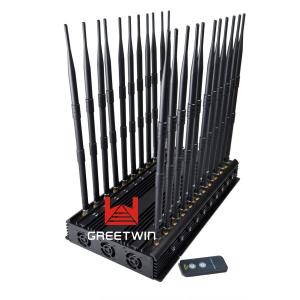
Add to Cart
22 Antennas VHF UHF 4G Mobile Cell Phone Jammer Blocker
GPS L1 L2 L5 Lojack WiFi 2g 3G Cell Phone Jammers
Signal Jammer Specification:
| No. | Output Port | Frequncy | Average Output Power |
| 1 | CDMA/RC868 | 850-894 MHz | 35 dbm / 3W |
| 2 | GSM | 925-960 MHZ | 35 dbm / 3W |
| 3 | DCS | 1805-1880 MHZ | 33 dbm / 2W |
| 4 | 3G | 2110-2170 MHZ | 33 dbm / 2W |
| 5 | 4G800 | 758-821 MHZ | 35 dbm / 3W |
| 6 | 4G2600 | 2570-2690 MHZ | 30 dbm / 1W |
| 7 | 4G2500 | 2500-2570 MHZ | 30 dbm / 1W |
| 8 | 4G2300 | 2300-2400 MHZ | 30 dbm / 1W |
| 9 | 5G 1500 | 1427-1518 MHZ | 33 dbm / 2W |
| 10 | 5G 3.4G | 3300-3600 MHZ | 30 dbm / 1W |
| 11 | 5G 3.8G | 3600-3900 MHZ | 30 dbm / 1W |
| 12 | 5G 4.0G | 3900-4200 MHZ | 30 dbm / 1W |
| 13 | WIFI 2.4G 11.b, g | 2400-2500 MHZ | 30 dbm / 1W |
| 14 | WIFI 5.2G 11.a | 4900-5500 MHZ | 30 dbm / 1W |
| 15 | WIFI 5.8G 11.a | 5500-5900 MHZ | 30 dbm / 1W |
| 16 | GPS: L1 + Glonass L1 | 1570-1580 Mhz | 33 dbm / 2W |
| 17 | GPSL2+L5 + Glonass L2 | 1170-1280 MHZ | 33 dbm / 2W |
| 18 | GPSL3+L4 | 1370-1390 MHZ | 33 dbm / 2W |
| 19 | Lojack Car Tracking | 167-175 MHZ | 35 dbm / 3W |
| 20 | VHF | 135-175 Mhz | 35 dbm / 3W |
| 21 | UHF/RC433 | 400-470 MHZ | 35 dbm / 3W |
| 22 | RC315 | 315 MHZ | 35 dbm / 3W |
| Power supply: AC adapter 50 to 60 Hz, (110 or 220V AC-12V DC) Car storage battery Charger DC12V | |||
| Dimensions: 450x 238x 60 mm (not include signal antenna) | |||
| Packing size: 55*44*15 CM Net weight: 7 KGS Gross weight: 8.0 KGS | |||
| Total power: 42 Watts Shielding radius: From 2 to 40 meters at -75dBm Still depends on the strength signal in given area, Shielding radius of VHF/UHF signal about 10meters | |||
| Warranty: one year from delivery date | |||




Applications:
1. It can be applied at meeting rooms, conference rooms, museums, galleries, theatres, concert halls, churches, temples, restaurants, classrooms, training centers, factories, banks, trains, bus and more Places that require silence, confidentiality, and information security
2. For some locations of special purpose such as hospitals, gas stations, and more, please do a field test first to make sure no interference happened to the normal operation of their equipment and instrument
